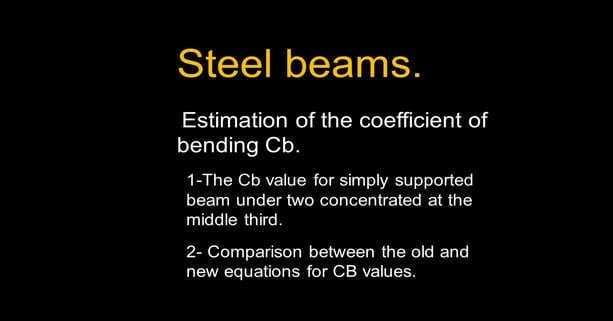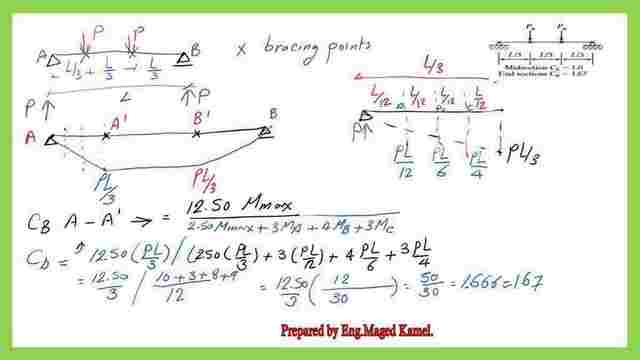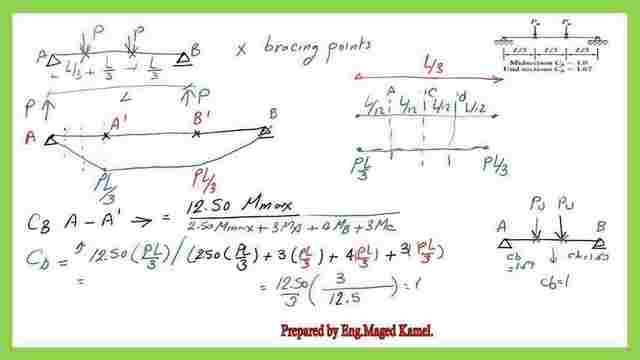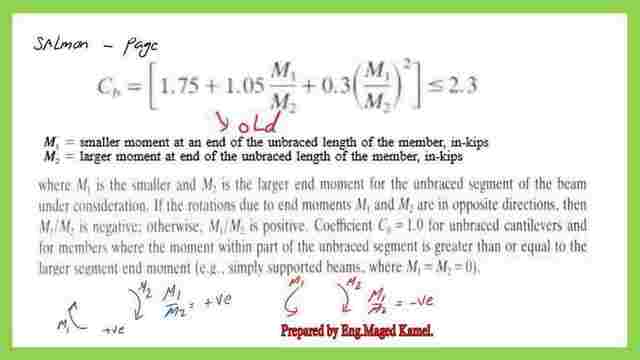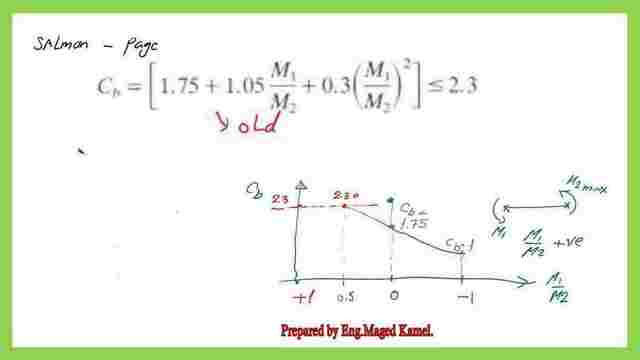Cb-The coefficient of bending part 2 for steel beams.
How to estimate the CB- coefficient of bending values for a simply supported beam under two concentrated loads.
We will talk about a new subject, how to determine the Cb and the calculation for different loading and bracing.
There is another example for the case of a simply supported beam acted upon by two concentrated loads of Pult value for each.
According to the table, the beam has 4 bracings, two are located at both ends, and the other two are at one-third of the span. The CB at the middle third=1.00, while the CB value for the first 1/3 of the span and the last third is=1.67. We want to prove that value.
Assume we have 4 bracings at A, A’, B’, and B as shown in the sketch. We will estimate the value of Bending moments and multiply these values by the coefficients. The numerator has a 12.50 factor.
While the sum of the coefficients at the denominator is also=12.50. The reaction value at the left support is P at the left and at the right support as well.
For the Bending moment diagram, the moment at A’=P*L/3 is a positive value. and the same value of moment=P*L/3 is at point B’. The Bending moment values are equal and between points, A’ and B’ are a straight line. For the part from A to A’, we will enlarge the bending moment values, and divide that part into 4 quarters.
The span length is L/3, after dividing by 4, each distance will be =L/12 since we have 4 quarters.
Since the Moment at A’=P*L/3, since the bending moment is in the form of a line, the values of the moment at each quarter can be found. MA=P*L/12, at b Mb=P*L/6, at c Mc=P*L/4. We refer back to the equation of the CB. M-max is still P*L/3.
For the denominator(2.50*Max), which is 2.50*P*L/3,+3*Ma, which is =3*P*L/12, 4Mb=4*P*L/6, 3*Mc=3*P*L/4.
Taking P*L as a common factor for both the numerator and the denominator, then cb=(12.50*1/3)/(taking 12 as a common factor). (10+3+8+9)=30 all divided by 12. Cb=12*12.50/(3*30),then cb=4*12.50/30, cb=50/30=1.666, or cb=1.67 as an approximate value. Since it is symmetrical concerning the middle, then the CB value for part b’B=1.67. Let us consider the middle part, from A’ to B’. The bending moment is a constant value=P*L/3.
Again divided into 4 quarters. All moment values are the same=P*L/3, cb=12.50*(P*L/3)/12.50(P*L/3), then cb=1, so for the middle third CB value is =1. Again I draw a small sketch, and P will be written as Pult.
Old Equation to Estimate CB, Coefficient Of Bending Value.
Another subject by God’s will. From Prof. Salmon’s book. there was an old expression used to evaluate the value of the CB as shown. For the older versions of AISC. Some reference books are still included, that is why I have indicated them here.
We will compare the coefficient of bending values obtained via the two equations.
The old equation includes that, cb=(1.75+1.05*(M1/M2)+0.30*(M1/M2)^2)<=2.30, where M1<M2, M1 smaller moment at the end of the unbraced length of the member. M2 larger moment at the end of the unbraced length of the member. If M1 rotates in the same direction as M2, then M1/M2 is considered positive.
But if both M1 and M2 rotate against each other, then M1/M2 is considered negative, this consideration will make a different calculation of the value of the CB-coefficient of bending. Since the sign of M1/M2 is important.
I quote, if M1 is the smaller and M2 is the larger end moment for the unbraced segment of the beam under consideration if the rotations due to end moments M1 and M2 are in opposite directions, then M1/M2 is negative, clockwise against anticlockwise otherwise, M1/M2 is positive. The value of the CB- the coefficient of bending equals 1.
For the unbraced cantilevers and the members where the moment within part of the unbraced segment is > or=to the larger segment end moment simply supported beams, where M1=M2=0.
Since for simply supported larger moment as W*L^2/8 under a uniform load can be obtained in the middle of the span, then, in this case, cb=1, while in the new method CB-coefficient of bending=1.14.
Based on the previous equation, we can plot a graph for the value of the CB. If we consider the x-axis as M1/M2. the y-axis is the value of CB. For the x-axis, the zero value is in the middle and the negative value is to the right, while the positive value is at the left.
Now let us check, this is the definition of the directions of M1 and M2 for the positive direction. This is the definition of the directions of M1 and M2 in a positive direction. We will substitute in the equation, that when M1/M2=0, then the coefficient of bending cb=1.75.
When M1/M2=+1, then the value will be >2.30, which. is not permitted.
The sum is =3.10, so the graph indicates that cb=2.30.The graph is a little bit curved at M1/M2=-1, cb=1.75-1.05+0.30=+1, it is shown on the graph.
The discussion will be continued in the next post.
This is the pdf file used for the illustration of this post and the next post.
For more detailed illustrations in the CB, please follow this link. Flexural Limit State Behavior
This is the complete list of all posts related to Cb:
1-Introduction to Cb-Bending coefficient part-1 for the steel-post 17-previous post.
2- Cb-The coefficient of bending part 2 for steel beams-post 18-this post.
3-Cb-The coefficient of bending part-3 for steel beams-post 18a -next post.
4-Cb value-bracing at the midpoint of a beam-uniform load-Post 18b.
5-Cb value bracing at third points of a beam-U load-Post18C.

